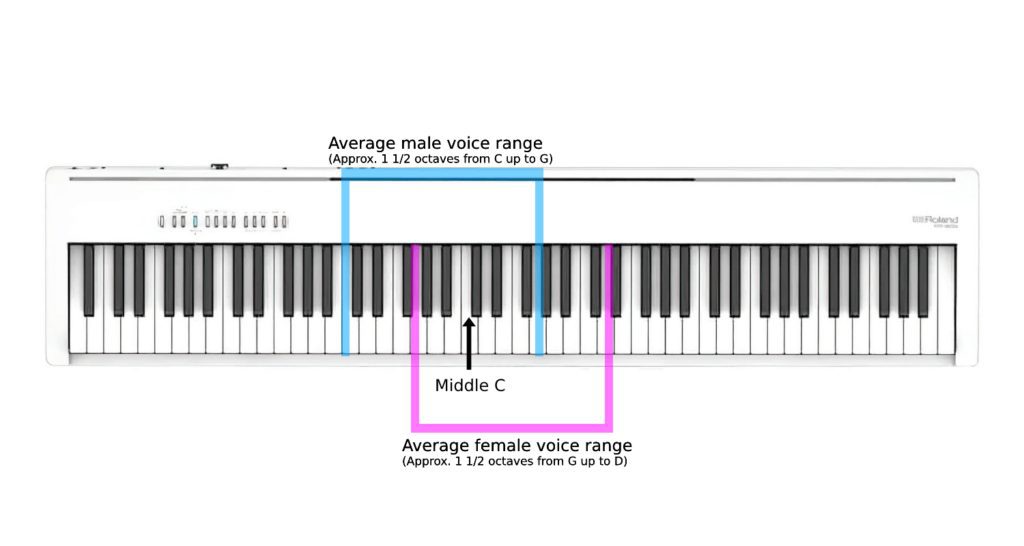Are you looking to learn practical singing tips for beginners to help you bring out your natural singing voice? This article will help you “unlock” the natural qualities of your voice by helping you understand the relationship between the effortless tonal qualities of your speaking and singing voice. Through videos and step by step exercises that you can be done at home, you too can learn to sing beautifully and effortlessly. For more information, be sure to read the ultimate singers guide on how to improve your singing.
#1: Find Your Natural Speech-Pitch Range
The first of our singing tips for beginners is to discover your vocal range in order to find your most natural, comfortable, and efficient speech-pitch range. This is important because your singing voice is highly related to your speaking voice. The goal is to bring out the natural qualities of your speaking voice and allow them to permeate and reflect your singing voice.
To find your natural speech-pitch range, start by exploring your speaking range. You can do this by using everyday vocal sounds like yawning, sighing, crying, and light coughing. These unrestricted sounds are great indicators of your uninhibited natural vocal range.
Singing Tips for Beginners: Demo 1
Let’s start with some yawning.
1st I don’t want you to think about it too much.
2nd We’ll do a couple. You might even find yourself genuinely yawning for several of them the more you relax
3rd For each yawn see if you can feel how it vibrates within your body
Demo 2
Now we’ll do some sighing, taking the same approach we did for yawning.
1st I don’t want you to think about it too much.
2nd We’ll do a couple on “Ah”
3rd For each sigh, see if you can tap into how the sound feels and vibrates within your body (from your head to chest and/or chest to possibly lower)
Here’s a couple of questions to ask yourself while you consciously exercise these common vocal sounds:
- did it feel effortless?
- did I feel any discomfort or tension in my throat?
- did I experience any differences in the expanse of my range?
When you try these unrestricted sound exercises again, ask yourself these questions.
Take away: Exploring and locating your speaking range is a necessary and solid start to working through the connection between your speaking and singing voice, in the pursuit of achieving effortless and tension free singing.
#2 Using Your Speaking Voice and a Piano to Explore Your Range
To explore your vocal range, you can sit at a piano or keyboard and use it as a guide. Check the pitch levels of your voice against the notes on the piano. Begin with the lower pitches and work your way up to the highest ones. As you play each note, focus on matching it with your voice.

Common voice ranges for men and women
- Soprano: The soprano is the highest vocal range and is typically associated with female singers. Sopranos can effortlessly sing high notes with clarity and precision, usually ranging from C4 to C6.
- Mezzo-soprano: The mezzo-soprano range is a medium-high range that is also commonly used by female singers. The mezzo-soprano range is slightly lower than the soprano range, usually ranging from A3 to A5.
- Alto: The term “alto” is usually used to describe a female vocalist with a lower vocal range, typically ranging from F3 to F5. However, the term “countertenor” is often used to describe male vocalists with a similar range.
- Tenor: The tenor is the highest male vocal range and is commonly used by male singers. The tenor range is typically from B2 to B4.
- Baritone: The baritone is a medium-high male vocal range that is lower than tenors but higher than basses. The vocal range of a baritone is often compared to that of a tenor, usually ranging from G2 to F4.
- Bass: The bass range is the lowest male vocal range and is characterized by its full, rich tone. Bass singers can effortlessly hit the lower notes, usually ranging from E2 to E4.
Piano Speech Pitch Exercise:
To check the pitch levels of your regular speaking voice, try using a piano. Simply speak in a natural and conversational tone, using phrases like “How are you?” or “My name is __.” As you speak, match the pitch of your voice to the notes on the piano to determine the range of your speaking voice. This exercise can help you become more aware of the natural pitch of your voice and can serve as a useful reference point for future vocal exercises.
Demo 1
“Hey, how are you doing?” ……”la, la la la la-la”
As you can hear, these inflections have actual pitch.
Now let’s try matching notes on the piano to the pitch levels of your speaking voice. You can use a piano app if you don’t have a keyboard or even a guitar if you play.
Demo 2
1st You’re going to start by finding the lowest of the white keys on the piano that your speech-pitch can match comfortably.
2nd Then you’ll start making your way up the piano, note by note, matching your speech-pitch to the piano.
3rd You can use any word or syllable for this, but to demonstrate how you’ll want to approach this, I’ll just say “Hey” or “Ah”
At first the differences in speech-pitch to notes may not blatantly be obvious to you, as you’re trying to figure out what to listen for. A good way to remedy that would be to record yourself.
Take away: You might be discovering new parts of your voice that you never knew you had. Again, this will help you uncover your most natural, comfortable, and efficient speech-pitch range.
Tip #3: Recording Yourself
It can be difficult to gauge if you’re achieving your intended goals during vocal exploration exercises, especially as you navigate how your body feels during the process. One of the often overlooked singing tips for beginners is to recording yourself in order to reference and evaluate your progress. Use a video camera, a tool like Garage Band or simply a common audio recorder for this.
Speak a passage of a song or written passage and record it:
To take your vocal exploration further, try recording yourself while reading a short text passage or singing song lyrics using your regular speaking voice. Gradually increase your pitch level while reading or singing the same passage, paying attention to where you feel the least vocal stress and where you feel the most comfortable, even if it feels unusual or unfamiliar. Avoid pushing yourself too hard. Take note of how the tone, color, and volume of your voice change as you move up and down your vocal range.
Tip # 4: Support you Breath Using you Diaphragm

I enjoy calling this activity the “diaphragm stretch” since it helps me imagine the diaphragm descending, the rib cage lifting and expanding, and the lungs filling up with air as I inhale. However, the term is not entirely precise because as soon as we start exhaling, the diaphragm returns to its original concave shape and no longer aids in supplying air. To generate the necessary resistance, we must engage our core muscles, including the abdominal and back muscles.
[Demo PROMPT] Breath Awareness
With regular practice a few times a week, you may discover that singing without running out of breath becomes less difficult.
Tip #5: How to sing high notes
In my experience working with students, whether male or female, who struggle to sing higher notes, I have found it helpful to employ the method of using “everyday expression” to investigate the boundaries, length, and range of their voice. We frequently engage in ordinary activities such as yawning and sighing without much forethought, and often with no reservations. The pitch of our voice during common emotional states such as surprise or sadness is individual and distinct for each person. We never question or judge the sound of our yawns or sighs.
The following video explores three effective techniques to help you access high notes while singing, without tension.
[Demo PROMPT] High notes
Take away: Through techniques such as utilizing everyday speech inflections in a sing-song manner or practicing lip trills and sirens while singing higher notes, you can access a more natural and effortless range in your vocal abilities.
Conclusion
I hope the following singing tips for beginners was helpful for you. You should immediately start feeling a difference in your singing once you begin to work on the exercises in this article. Remember that nothing worthwhile happens overnight, so make sure to return to these exercise on a regular basis. Approach this material with an open mind and be compassionate towards yourself. If you’re looking for some additional assistance, please be sure to visit singing lessons Montreal, Singing lessons Toronto or Singing lessons Vancouver, to find a qualified singing coach to help you.


